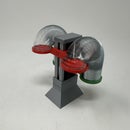Introduction: Crayon Car Mechanism.
A few weeks ago, a video appeared in my recommended video feed from Tim at GrandIllusions (https://www.youtube.com/c/grandillusions) showing a crayon line following toy car designed forty years ago that had no electronics whatsoever, but no operational details were provided (Tim was perplexed regarding how the car operated).
Not long after that, John at RobotHut (https://www.youtube.com/user/Robothut) sent me a link to a video of a design he created of a three motor version of the crayon following car.
Between the two videos, and always loving to design, 3D print and assemble mechanisms, I designed this single motor crayon following car using a flexible 3D printed TPU axle to transfer rotary motion from the rear wheel to the front wheels.
The theory behind the design is elegantly simple. A single rear wheel drives the car forward while the counter rotating front wheels "sense" the crayon line. When the counter rotating front wheels come in contact with the sticky wax crayon line, they are designed to steer the car away from the line. The front wheels in my design spin 1.75 times faster than the rear wheel to allow time for the vehicle to make line following corrections.
In this video, I drew the crayon line on two sheets of 8.5" by 11" standard copy paper that I had taped together. It is important to have a heavy crayon line for the vehicle to work (maybe that explains my poor crayon coloring skills?).
I thought the mechanism was pretty neat, and our grandson was enthralled by it! Many thanks to both Tim and John!
As usual, I probably forgot a file or two or who knows what else, so if you have any questions, please do not hesitate to ask as I do make plenty of mistakes.
Designed using Autodesk Fusion 360, sliced using Cura 4.12.1, and printed in TPU and PLA on Ultimaker S5s.
One final note, I receive no compensation in any form for the design, parts and/or materials used in this model.
Supplies
Soldering Iron.
Solder.
Thick cyanoacrylate glue.
Double sided sticky tape.
Step 1: Parts.
To assemble this model, I acquired the following parts:
- One 3.7vdc 100ma Lithium Battery (https://www.adafruit.com/product/1570).
- One JST PH 2-Pin Cable (https://www.adafruit.com/product/3814).
- One N20 6VDC 100RPM to 120RPM gear motor.
- One O-Ring, R-18 (22mm ID, 3.5mm section).
And I designed and 3D printed the following parts using PLA (unless otherwise noted) at .15mm layer height, 20% infill:
- One "Axle, Flex.stl", 3D printed using TPU filament on a TPU raft with TPU support.
- One "Axle, Gear, Bevel (1.8m, 8t), Axle, Flex.stl".
- Two "Axle, Wheel, Font.stl".
- One "Axle, Wheel, Rear.stl".
- One "Bushing, Axle, Font, Flex.stl".
- One "Bushing, Axle, Front.stl".
- One "Bushing, Axle, Wheel, Rear.stl".
- One "Chassis.stl".
- One "Gear, Bevel (1.8m, 8t), Axle, Flex.stl".
- One "Gear, Bevel (1.8m, 14t).stl".
- One "Gear, Motor (1.8m, 12t).stl".
- Two "Wheel, Font.stl".
- One "Wheel, Rear.stl".
This is a high precision print and assembly model using at times very small parts and in very tight spaces. Prior to assembly, test fit and trim, file, sand, etc. all parts as necessary for smooth movement of moving surfaces, and tight fit for non moving surfaces. Depending on you printer, your printer settings and the colors you chose, more or less trimming, filing and/or sanding may be required. Carefully file all edges that contacted the build plate to make absolutely certain that all build plate "ooze" is removed and that all edges are smooth. I used small jewelers files and plenty of patience to perform this step.
Attachments
 Axle, Flex.stl
Axle, Flex.stl Axle, Gear, Bevel (1.8m, 8t), Axle, Flex.stl
Axle, Gear, Bevel (1.8m, 8t), Axle, Flex.stl Axle, Wheel, Front.stl
Axle, Wheel, Front.stl Axle, Wheel, Rear.stl
Axle, Wheel, Rear.stl Bushing, Axle, Front, Flex.stl
Bushing, Axle, Front, Flex.stl Bushing, Axle, Front.stl
Bushing, Axle, Front.stl Bushing, Axle, Wheel, Rear.stl
Bushing, Axle, Wheel, Rear.stl Gear, Bevel (1.8m, 8t), Axle, Flex.stl
Gear, Bevel (1.8m, 8t), Axle, Flex.stl Gear, Bevel (1.8m, 14t).stl
Gear, Bevel (1.8m, 14t).stl Chassis.stl
Chassis.stl Gear, Motor (1.8m, 12t).stl
Gear, Motor (1.8m, 12t).stl Wheel, Front.stl
Wheel, Front.stl Wheel, Rear.stl
Wheel, Rear.stl
Step 2: Motor Preparation and Installation.
To prepare the motor and install it, I performed the following steps:
- Soldered JST connector wires to the motor so that when power is applied, the motor rotates clockwise as viewed from the axle end.
- Pressed the motor assembly into "Chassis.stl".
Step 3: Gear Train Assembly.
To assemble the gear train, I performed the following steps:
- Positioned "Gear, Motor.stl" in the chassis assembly, then slid the motor into the hole in the gear, and finally centered the gear in the chassis slot.
- Slid the O-Ring onto "Wheel, Rear.stl".
- Positioned the rear wheel in the chassis assembly.
- Secured the rear wheel to the chassis using "Axle, Wheel, Rear.stl".
- Pressed "Bushing, Axle, Wheel, Rear.stl" onto the rear wheel axle, making certain the rear wheel rotated freely.
- Pressed "Gear, Bevel (1.8m, 14t).stl" onto the rear wheel axle (a small dot of glue may assist in retaining the gear on the axle).
- Placed "Axle, Gear, Bevel (1.8m, 8t), Axle, Flex.stl" into the chassis assembly.
- Pressed "Gear, Bevel (1.8m, 8t), Axle, Flex.stl" onto the axle (a small dot of glue may assist in retaining the gear on the axle) making certain the gear rotated freely.
Step 4: Front Wheel Assembly.
To assemble the front wheels, I performed the following steps:
- Positioned one "Wheel, Front.stl" into the chassis assembly.
- Secured the front wheel in the chassis using one "Axle, Wheel, Front.stl".
- Positioned the remaining "Wheel, Front.stl" into the chassis assembly.
- Secured the remaining front wheel in the chassis using the remaining "Axle, Wheel, Front.stl". This is a very complicated step. I pinched the two front wheels together with one hand, made certain the gear teeth were aligned, then used plenty of pressure to engage the gears.
- Pressed "Bushing, Axle, Front.stl" onto the right front axle shaft (a small dot of glue may assist in retaining the bushing on the axle).
Step 5: Final Assembly and Track Preparation.
For final assembly, I performed the following steps:
- Pressed "Bushing, Axle, Front, Flex.stl" onto the left front wheel axle (a small dot of glue may assist in retaining the bushing on the axle).
- Pressed one end of "Axle, Flex.stl" into the small bevel gear.
- Pressed the remaining end of the flex axle into the left wheel flex bushing.
- Placed double sided sticky tape onto the battery.
- Pressed the battery into the chassis assembly.
With the model assembled, I used a wax crayon to draw a circle on a piece of smooth paper (as seen in the video, my circle is perhaps a little too small but I made it that size to fit in my photo booth). The crayon circle is about one inch wide, and is applied to the paper very thick. Once my circular track was completed, I placed it on a smooth, flat, level surface, powered up the model, placed the front wheels astride the crayon circle, and let it go! If the model veers off the track at a particular point, simply add more crayon.
And that is how I 3D printed and assembled "Crayon Car Mechanism".
I hope you enjoyed it!

Second Prize in the
Toys and Games Contest


























